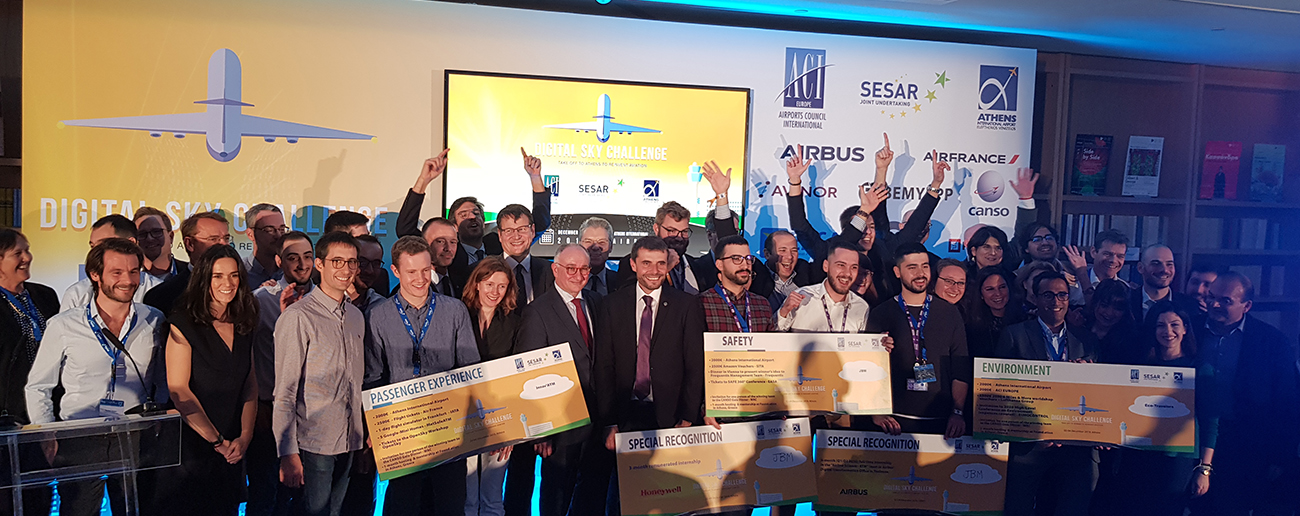Airspace design, the integration drones, machine learning and automation were just some of the research themes of this year’s SESAR Innovation Days (SIDS), which took place between 2-5 December in Athens. Bringing together over 400 participants, the event celebrated in particular young talent in aviation with the awarding of the Young Scientist Award and the Digital Sky Challenge.
SESAR Innovation Days

Hosted by the National Centre of Scientific Research (NCSR) "Demokritos", this year’s SIDs showcased results from European exploratory research on air traffic management (ATM). Main highlights of the event included:
- 38 papers on a wide variety of topics including: airport operations, network flow management, complexity and data science, human factor, modelling and simulation techniques, machine learning, decision support tools, drones, meteorology, conflict detection, airspace architecture and design.
- 21 posters presenting research on a variety of themes, including blockchain technologies for drones, safety net solutions, data-driven predictability tools, detection and tracking technologies for airport surface management, etc
The event also featured a panel with experts, who discussed the move towards advanced levels of automation in the ATM system. While there was a common consensus on the need for increasing levels of automation to cope with the traffic, the experts highlighted several areas needing particular attention, such as the human factor, change management, cyber resilience, certification and societal acceptance of the use of automated systems in a safety-critical industry such as ATM/aviation.
Attracting young talent was also a recurring theme at the conference. In a dedicated panel, representatives from European and International aviation/ATM noted that bringing new blood into research and innovation will be the make or break of the aviation/ATM industry. They underlined the need for the ATM research community to become more open and embrace other disciplines to enrich its knowledge and expertise.
Engage, the SESAR JU’s network for knowledge transfer, is supporting this effort through a wide range of activities, which Andrew Cook from Westminster University presented at this year’s SIDs. These include summer schools, thematic challenge workshops, catalyst funding and grants to support the participation of younger researchers at industry/academic events.

This is very much aligned with the SESAR digital academy, an initiative that the SESAR JU is working on to attract young talent with a skillset matching the needs of the future ATM system.
Proof of the current pool of talent was during the SESAR Young Scientist Award ceremony, which featured presentations from the three short-listed scientists. In third place, Leonid SEDOV, Linköping University, was recognised for his research on capacity estimations and route planning for the management of dense drone traffic in very low level (VLL) uncontrolled airspace. Javier Alberto Perez Castan from Universidad Politécnica de Madrid was awarded the second place for his research into continuous climb operations in high-density scenarios to reduce the capacity and safety impact of traffic around airports.

Finally, this year’s top award went to Junzi Sun, Delft University of Technology, for his novel scientific approaches to modelling different aspects of aircraft performance. Rooted in the philosophy of open data and open models, the results of this research provide a framework that enables more transparency and comparability for future ATM research.
- Download the SIDs 2019 papers
- View the SIDs 2019 posters
- View the presentations from the SESAR Young Scientist winner and runner-up winners
- View pictures from SESAR Innovation Days 2019
The conference closed with the announcement that the next SESAR Innovations Days will take place in Budapest
Digital Sky Challenge
SESAR Innovation Days was a perfect backdrop to organise the Digital Sky Challenge, an innovation sprint of 48 hours where 12 competing teams from across Europe were asked to come up with solutions addressing safety, environment and a better passenger experience. Taking place at Athens Airport, the Challenge aimed to see what could be achieved by harnessing big data and AI technologies for aviation.
Co-orgnaised by Athens Airport, ACI Europe and the SESAR JU with 23 other parners, over the two-day the teams developed their solutions from several data sources, which they first pitched to 19 mentors and then to a jury made up of aviation experts. The winners were announced at an awards ceremony held in the Stavros Niarchos Foundation:
Passenger experience challenge winner: Innov’ATM developed an innovative app to track passengers with their consent, so that airlines, airports and air traffic control know where they are.
Safety challenge winner: With no prior background, JBM successfully developed from scratch a safety-net in 48 hours capable of analysing distances between aircraft in order to alert of potential incidents. JBM also received two special recognition prizes from Honeywell and Airbus.
Environment challenge winner: The Eco-Travellers (from Sopra Steria) developed a tool to allow passengers select the best and most green mobility option, integrating multiple modes of transport. The tool took into account existing systems and offsetting schemes.
- Read more about the Digital Sky Challenge and winners
- Watch the wrap-up movie
- View pictures from the Digital Sky Challenge Awards

